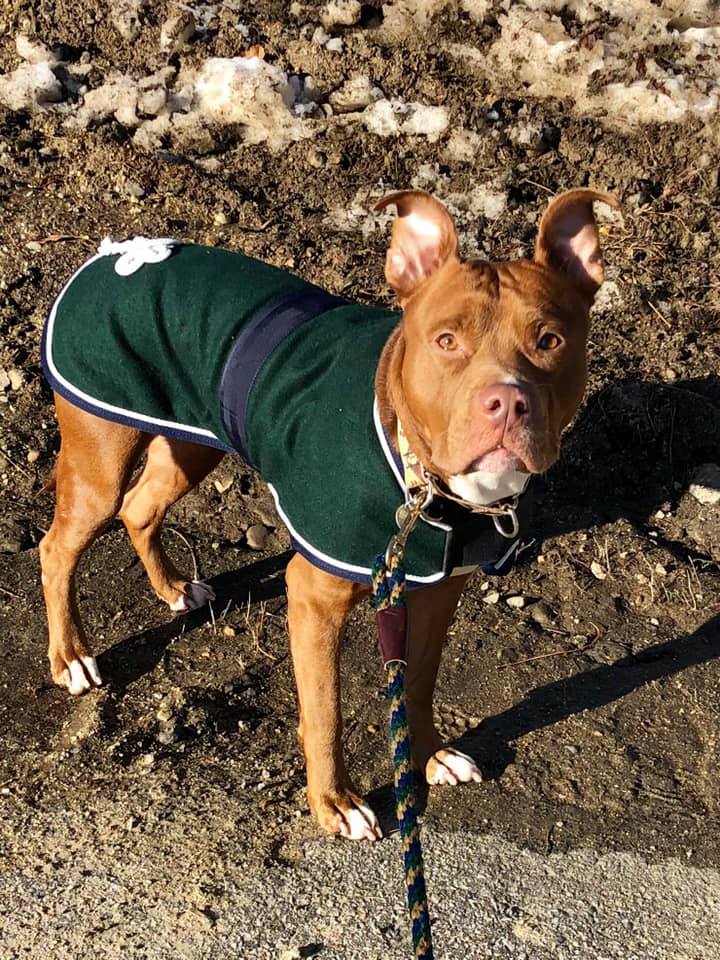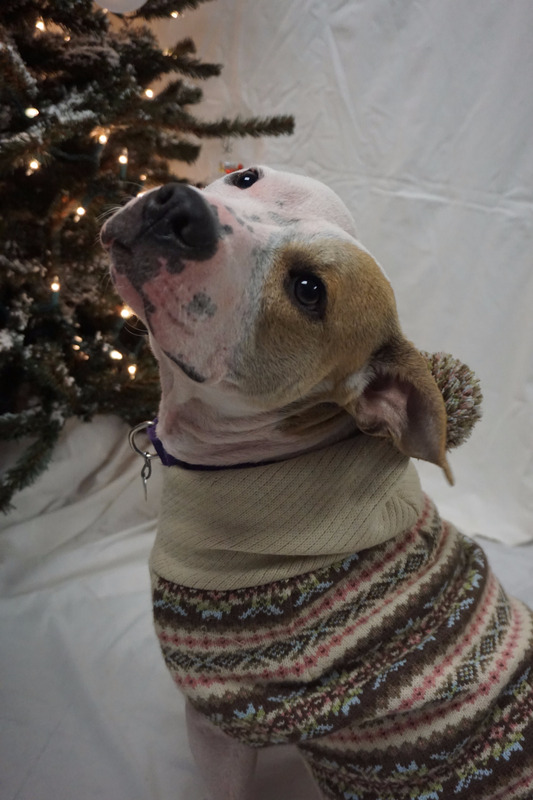We’re turning up thermostats, dusting off snow blowers, and breaking out heavy sweaters. Winter is definitely here! Winter in New England can be severely cold, with Nor’easters pummeling us relentlessly. We know that we need heavier jackets and warmer socks to stay safe this winter, but what do our furry friends need? Here are some tips to keep your pets healthy, happy, and safe during the most brutal season.
Bundle Up!
 When heading outdoors with your pets, keep in mind that if you’re putting on a coat, they probably should, too! Although our pets may have fur, it isn’t enough to keep them warm for long periods of time in freezing temperatures. Your pet’s temperature tolerance depends on the kind of fur they have. For example, thick-coated dogs, like huskies or Bernese mountain dogs, can withstand cold temperatures longer than a short-coated boxer. No matter how luxurious their natural coat, when temps drop below freezing, all dogs could use an extra layer when heading outdoors for extended periods of time. Make sure your dog’s coat fits well, snug but not tight, and covers from their neck to the base of their tail.
When heading outdoors with your pets, keep in mind that if you’re putting on a coat, they probably should, too! Although our pets may have fur, it isn’t enough to keep them warm for long periods of time in freezing temperatures. Your pet’s temperature tolerance depends on the kind of fur they have. For example, thick-coated dogs, like huskies or Bernese mountain dogs, can withstand cold temperatures longer than a short-coated boxer. No matter how luxurious their natural coat, when temps drop below freezing, all dogs could use an extra layer when heading outdoors for extended periods of time. Make sure your dog’s coat fits well, snug but not tight, and covers from their neck to the base of their tail.
A coat will only go so far, as it insulates just the core of your pet’s body. Noses, tails, ears, and paws are most susceptible to frostbite in the winter. While you can’t do much clothing-wise for noses, tails, and ears, you can limit time outdoors when the weather becomes extremely cold. For paws, you can try convincing your pet to wear some boots! Like coats, be sure that the boots are snug, not tight, before taking your dog out for a walk. Tight boots can cut off circulation, increasing the risk for frostbite!
(Note: We do not recommended leaving your pet unsupervised while wearing a coat. Clothing can get stuck on objects and become dangerous. If your pet’s clothing gets wet, it can increase the risk of hypothermia. Be sure to have a couple of coats on hand, so you always have a dry one ready! Additionally, coats and sweaters are recommended mostly for canine companions. Cats tend to be less tolerant of garments and could hurt themselves trying to get out of them.)
Wipe Your Paws!
Snow and ice can clump between your pet’s paw pads, making their feet more susceptible to frostbite. One way to prevent this is by clipping the hair between their pads, so it’s more difficult for snow to get stuck there. Wiping your pet’s paws with a towel when they come inside, or periodically during walks, can also prevent ice and snow buildup.
Toweling off their paws can also help protect them from toxic winter chemicals. Salts, ice melts, and anti-freeze can be extremely dangerous to pets. Most of these products are highly toxic to your pets if ingested, which can occur easily if they lick their paws after being outside. Wiping your pet’s paws can help remove harmful residues, and keep your pet safe. If you suspect your pet may have ingested anti-freeze or ice melt, do not wait for them to show symptoms— take them to your vet immediately. Try to use pet safe ice melts whenever possible, to protect your furry friends and others in the neighborhood.
Be sure to check your pet’s paws often for cracks or sores. Much like human skin, paws can crack when exposed to cold, dry weather and artificial heat. Sharp pieces of ice can cut into your pet’s feet, and salts from the road can burn paws, causing painful sores. Boots, like we mentioned above, can help prevent these injuries. If your pet refuses to wear boots, you can also apply some petroleum jelly or paw protectants, like Musher’s Wax, to help prevent injury and soothe cracked paws.
Sleep Tight!
 What’s better than crawling into a warm, cozy bed at the end of a chilly winter’s day? Not much, and your pet would agree! It’s especially important to make sure your pet has a warm, safe place to sleep during the winter months. Inside the house, a bed with a cozy blanket should do the trick!
What’s better than crawling into a warm, cozy bed at the end of a chilly winter’s day? Not much, and your pet would agree! It’s especially important to make sure your pet has a warm, safe place to sleep during the winter months. Inside the house, a bed with a cozy blanket should do the trick!
If your pet likes to snuggle up next to your fireplace or on top of a radiator, make sure they stay far enough away so they don’t get burned. This may mean pet-proofing these areas to prevent your pets from getting too close or laying on top of heated elements. Be extra careful when using space heaters around pets, as they could knock them over or burn themselves.
While we strongly recommend keeping your pets (even your most outdoors-loving ones) inside during the frigid winter months, we know that’s not possible in some cases. For example, it won’t be possible to bring feral or “neighborhood” cats inside your home. However, you can provide an outdoor cat shelter relatively easily and at a low cost to keep local cats warm and safe in freezing weather. Learn how you can make one here.
Safety First!
Take extra precautions to keep your pets safe throughout the winter months. Even if your dog loves to roam during outdoor excursions, try to keep them close by or on a leash. Frozen bodies of water can be dangerous and easily concealed, and if your dog falls through some thin ice, it can turn into a potentially deadly situation for both of you.
Make sure your pet’s microchip info is updated and they have a well-fitting collar with tags, as pets can become lost more easily during the winter. When there’s snow on the ground, it’s harder for animals to track familiar scents that help them find their way home. It’s also not a bad idea to invest in a reflective or LED collar, since the increased darkness of shorter days can make pets harder to see.
 Cats tend to seek shelter from the cold in dangerous places. Make sure to check around your car and inside wheel wells for feline friends before driving. Banging on your hood or tapping your horn will also help to scatter any kitties that may have found shelter near your engine!
Cats tend to seek shelter from the cold in dangerous places. Make sure to check around your car and inside wheel wells for feline friends before driving. Banging on your hood or tapping your horn will also help to scatter any kitties that may have found shelter near your engine!
With holiday celebrations occurring all season long, make sure to keep your pets away from potentially hazardous foods and decorations. In our fall health tips post, we discussed the kinds of holiday foods that can be dangerous to your pets. Keep a close eye on your furry friends around the dinner table and in the kitchen during parties or cooking marathons. Seemingly harmless ingredients, like onions or nutmeg, can become toxic if ingested by your pet.
Popular decorations, such as tinsel or poinsettias, can also be dangerous. Try to keep potentially hazardous décor out of your pet’s reach, or out of the house all together—especially if you see your four-legged companion becoming a little too interested in these festive objects!
The winter can bring new challenges for your pet’s health, but with a little preparation and extra care, you can help them stay warm, safe, and healthy throughout the season! As always, make sure to keep up with regular vet visits, as well as heartworm and flea and tick preventatives. Just because it’s cold, doesn’t mean these creepy crawlers go away! New studies have found that ticks are now a year-round issue in New England (of course). If you ever have any urgent concerns about your pet’s health, contact your veterinarian. Wishing you and your four-legged friends a happy and healthy winter season!
